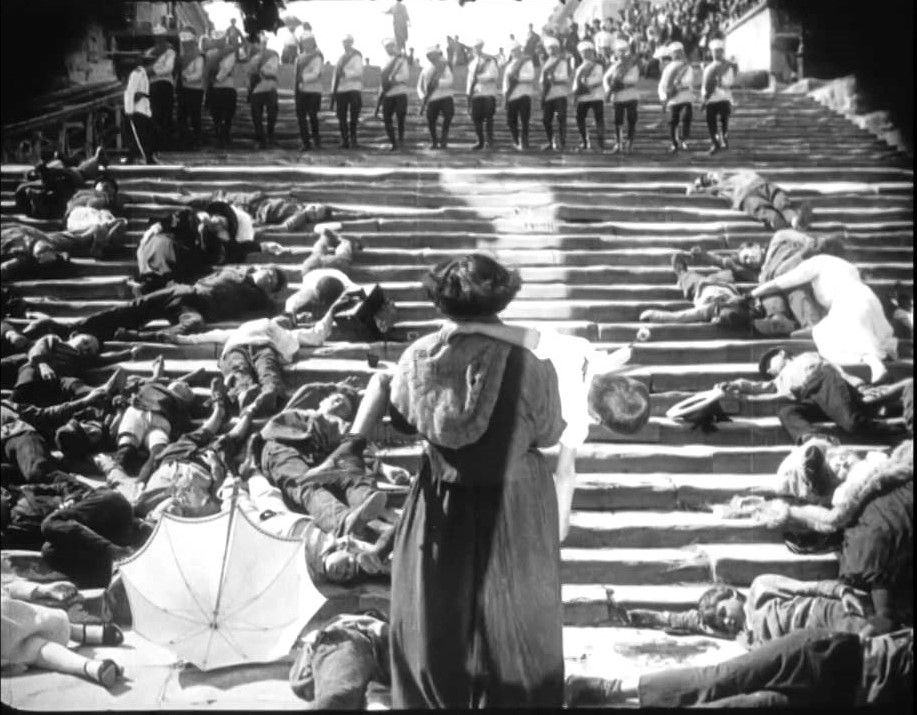Battleship Potemkin


United Kingdom
Battleship Potemkin is a silent film of the early Soviet era which depicts a Russian uprising. Produced to commemorate the Russian Revolution, the moving realism of Sergei Eisenstein’s directorial vision has been described as “the essence of revolutionary cinema: a film about a revolution, made as part of the revolution, in a revolutionary way” (Rose, 2010). Although in essence a propaganda film, Battleship Potemkin uses highly emotive subject matter and editing for dramatic effect in ways that pushed film-making in new directions.
The film begins on a battleship where the crew are roused from sleep by a revolutionary soldier named Grigory Vakulinchuk who gives a speech about Russia uprising against the Tsarist regime, a movement of which they should be apart. When the crew refuse to eat rotting meat they gather on the ship’s deck, where the ship’s captain orders them to be covered with canvas and executed. The soldiers refuse to shoot, and the battleship erupts in mutinous chaos in which soldier Vakulinchuk is shot and killed by senior officers. Some of his comrades take his body to shore, docking at Odessa where townspeople gather around the body. The townspeople show their support by bringing food and supplies to the ship, now flying a red flag. When the townspeople gather on the Odessa steps to wave them on their journey, they are besieged by Tsar soldiers who open fire indiscriminately. There is a rush of panic as frenzied citizens flee and hide. In a shocking sequence, some try to save their loved ones – a child is bloody and crying, being crushed by the crowd. A grandmother stands up to reason with the soldiers and is shot. A nurse tries to protect her child in a pram, and the pram is sent careening down the stairs. Eisenstein chose non-professional actors to be in this famous scene, who were able to represent their social role or societal ‘class’ in the way they looked (Dickstein, 2011). The ship responds by opening fire on the city. A Tsar squadron come for Battleship Potemkin in the night, and, when it seems their fate is inevitable, the Tsar soldiers surprisingly do not open fire, instead they are called ‘brothers’ when they allow Potemkin to sail past.
When first viewed in September 1926, the film proved controversial in the depiction of violence as well as political theme. Censor Colonel J.C. Hanna DSO, the former deputy chief of intelligence in Ireland (Petley, 2013, p155), rejected the film on the basis of “inflammatory subtitles and Bolshevist Propaganda” (BBFC, 2020). The BBFC were sensitive to such propaganda after the conservative government’s victory over a union strike that had lasted nine days in May of the same year (Robertson, 1993, p29). The BBFC would go on to censor other films considered to be Russian propaganda, such as Dawn (Wilcox, 1927) and Mother (Pudovkin, 1928) (Robertson, 2010). But one rogue revolutionary pushed the film’s presence in the U.K. Ivor Montagu, an aristocrat’s son with communist ambitions submitted Battleship Potemkin to the London County Council (LCC) and Middlesex County Council (MCC). However, these conservative councils also rejected the film. Battleship Potemkin was only screened privately for a few film societies and workers’ educational groups in London before the BBFC reviewed the film in the 1950s. By this time, silent films were not commercially viable nor seen to hold the same threat. The film was released uncut with an X rating for adults over sixteen in 1954. Today, the film has inspired many other creations and is still counted as one of the greatest films of all time by critics and directors alike. – Rachel Cole
Further reading:
BBFC website. “Battleship Potemkin” https://bbfc.co.uk/case-studies/battleship-potemkin
British Film Institute website. “Battleship Potemkin (1925)” https://www.bfi.org.uk/films-tv-people/4ce2b6a68bd9d
News article. Rose, S. (2010) “Battleship Potemkin: No 18 best arthouse film of all time” https://www.theguardian.com/film/2010/oct/20/battleship-potemkin-eisenstein-arthouse
Book chapter. Petley, J. (2013) “The Censor and the State in Britain”, in D. Biltereyst & R. VandeWinkel (ed.s), Silencing Cinema: Film censorship around the world (pp.149-165). New York: Palgrave Macmillan.
Book. Robertson, J. (1993) The Hidden Cinema: British Film Censorship in Action 1913-1972, Routledge: ebook.
Conversation article. Campbell, R. (2018) “Ivor Montagu: Communist aristocrat, Soviet spy and activist filmmaker” 12 September.
Journal article. Dickstein, M. (2011) “Battleship Potemkin and Beyond: Film and Revolutionary Politics”. Dissent. [Online] 58 (3), pp.90–95.